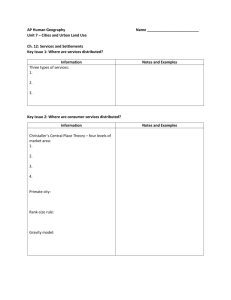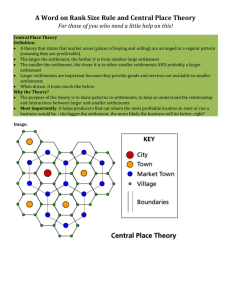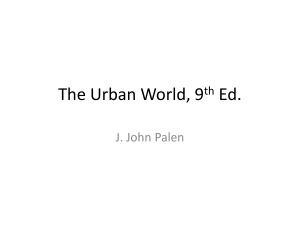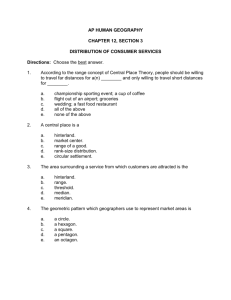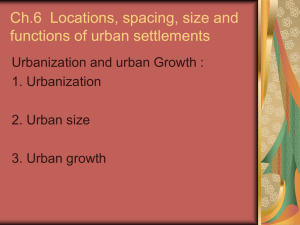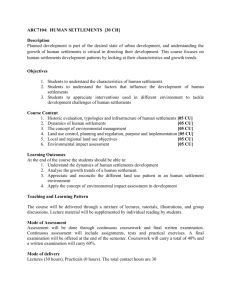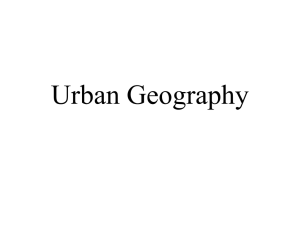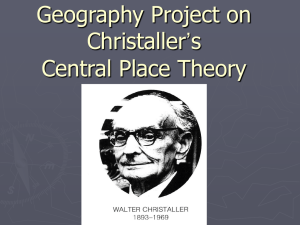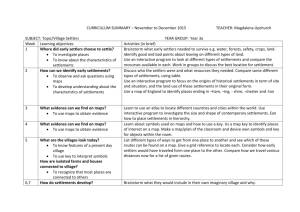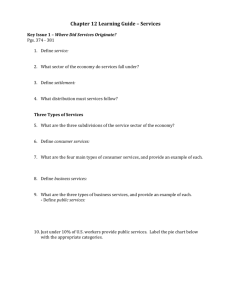Central-Place-Theory
advertisement
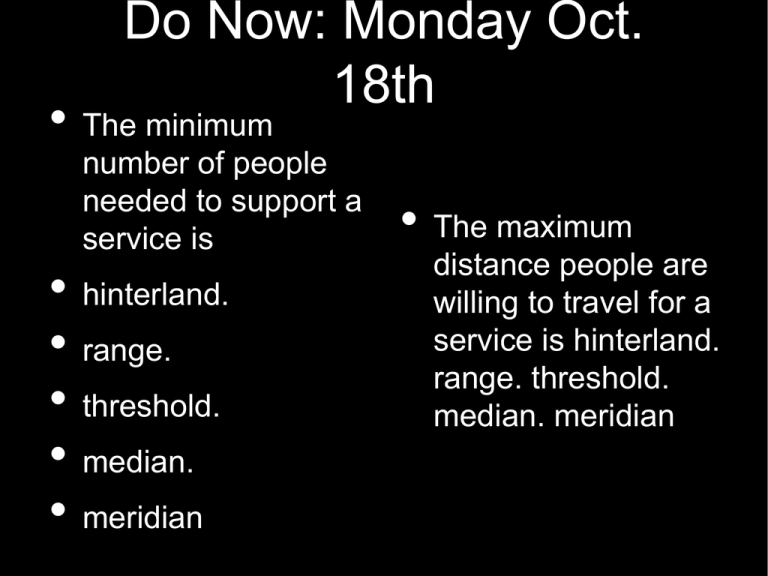
Do Now: Monday Oct. 18th • The minimum number of people needed to support a service is • hinterland. • range. • threshold. • median. • meridian • The maximum distance people are willing to travel for a service is hinterland. range. threshold. median. meridian • Define settlement. • A settlement is a permanent collection of buildings where people live, work, and obtain services. • A market area is a good example of what kind of region? • cultural • formal • functional • uniform • diverse • Larger settlements are • more numerous and closer together. • more numerous and farther apart. • less numerous and farther apart. • less numerous and closer together. • more numerous and evenly dispersed. • Residents of rural settlements are more likely than residents of urban settlements to work in • A) agriculture. • B) manufacturing. • C) services. • D) education. • E) all of the above Testing Calendar • Unit 1 Test: 10/26 10/27 • Chapter 12 and Chapter 13 • Additional materials from notes • Study Guides to be posted on the website • Middle East map quiz: 10/29 see website for the specific countries that you need to know and links to practice Objective: 10/18 • We will examine how geographers use models to predict the distribution of settlements and services • We will identify how the distribution of services and settlements impacts the lives of people living in MDCs vs. LDCs Edge City • • • • • Suburban cities on the outskirts of central city. 1. The area must have substantial office space (about the space of a good-sized downtown) & substantial retail space (the size of a large regional shopping mall); 2. The population must rise every morning and drop every afternoon (i.e., there are more jobs than homes); 3. The place is known as a single end destination (the place "has it all;" entertainment, shopping, recreation); 4. The area must not have been anything like a "city" in 1960 (cow pastures would have been nice). Models of Urban Distribution and Location • Models that attempt to explain why are specific services where they are in a city vs. the surrounding rural areas • Rank Size Rule • Central Place Theory Rank Size Rule • • • • • • pg. 410 George Zipf in 1949. A theory that the ideal urban system would have a regular pattern of settlements from biggest to smallest Population of a city is inversely proportional to it’s rank in the hierarchy 1/R x Population of Largest City R = rank Rank Size Rule • Second largest city is have the size of the largest. • Fourth biggest city is 1/4 the size of the largest. • etc. Rank Size Rule • Which country has the ranksize distribution of settlements? • Why do you want rank-size distribution? Primate City Rule • MDC’s that follow the rank-size distribution among smaller settlements, but not among larger ones • Primate City: largest settlement has more than twice as many people as the next biggest settlement. Primate Cities • Examples of Primate Cities: • Paris (9.6 million) is definitely the focus of France while Marseilles has a population of 1.3 million. • Mexico City, Mexico (21.2 million) is significantly larger than 2nd largest Guadalajara (1.6 million). Rank-Size Rule: What does it mean for peoples’ lives? • A regular hierarchy of settlements shows that the society has an even distribution of various order services for example, it might only take someone living outside a city 10-15 minutes to reach a doctor. • • In LDC’s, unequal distribution means in some areas, people have to travel further to get higher order services such as medical care, eductaion, or Ferarris. Most people in LDCs don’t have cars so they will have to travel likely for hours to obtain these services. Central Place Theory • The theory that explains the distribution of services, based on the fact that settlements serve as centers of market areas for services; larger settlements are fewer and farther apart than smaller settlements and provide services for a larger number of people who are willing to travel farther Central Places • Central places: urban centers that provide services to surrounding rural people called the hinterland • aka: village, hamlet, town CPT: Assumptions • Area has no variation in topography or climate • Rational behavior - people want to minimize distance they travel to obtain service • Even distribution - of population & resources • All consumers have similar purchasing power • Equal competition between goods and services* • Transportation costs are equal in all directions • • • Central Place Theory How do you calculate the market area, or hinterland of a given service? What shape would it be? Range Threshold • Low order services (bread, gas) • High order services (mac store, Ferrari dealership) CPT: Relevance • This is a model, not reality • Use of hexagons explain hierarchy and interconnectedness of places • Originally applied to Germany • Found to be applicable in China and the Midwestern US CPT: Limitations • • • • • Large, contiguous areas of flat land rarely exist There are many forms of transport - cost does not equal distance People and wealth are not evenly distributed People do not always go to the nearest good or service Services and goods are not all equal competitors So why use it? • • Use this idea of the equal distribution of services in planning new communities so that all people have access to important high order services and goods Just by looking at the model forces us to compare the model vs. reality - by explaining the difference we better understand the distribution of goods and services in urban settlements Exit Ticket • In your own words, summarize the following models: • Rank Size Rule • Central Place Theory
